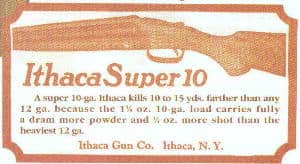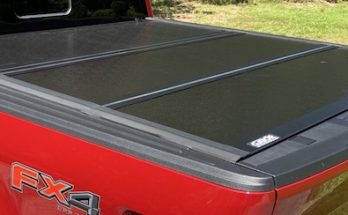I saw the Ithaca Super 10 photo above in a hunting magazine, touting the features of the big 10ga shotgun. Right off the bat I was excited about the extra shot and powder compared to the 12ga. That thing has a whole “dram” more powder than the 12ga. Then I got to wondering, was that a misprint–did they really mean it had a gram more powder than the twelve? What the heck is a dram? So, I thought it might be a good idea to try to sort out what all those numbers on a box of ammo mean.
Shot Shells
Modern factory loads are often labeled in ‘drams equivalent’. That means the powder charge in the shell is supposed to produce the same shot velocity as that many drams of black powder. So if the box is labeled 3 drams, that means the velocity will be the same as a black powder shell containing 3 drams of powder. A dram is an avoirdupois unit of measure and is the unit of weight used to measure black powder. There are 256 drams in a pound avoirdupois, 16 drams in an ounce, and 7000 grains in a pound.
1 ounce = 16 drams = 437.5 grains.
1 dram = 27.34375 grains = 1.772 grams.
1 gram = 15.432 grains = 0.564 drams.
Looking at the label from a box of Winchester Upland game loads, we see the following information from left to right. The gauge tells you the shells are for a 20 gauge shotgun, the shells can be used in a gun with a 2 3/4″ or longer chamber, it has a velocity equivalent to 2 1/2 drams of black poweder (about 1200 feet per second), it has 7/8 oz of shot, and the shot size is 71/2. Winchester now prints the actual velocity in feet per second (fps) on most of their shot shell ammo instead of listing dram equivalents.
Below is a table showing dram equivalent loads for 2 3/4″ shot shells. Many shot shell boxes now have the velocity printed on the box so you don’t have to estimate the velocity based on old dram equivalent data. For best results, purchase ammo based on the weight of the shot and velocity, but if the velocity is not printed on the box, the table below may help you determine the correct power for your intended use.
Gauge. The table shows the nominal bore sizes of the various gauges. The smaller the gauge the larger the bore of the gun.
The gauge number is the number of bore sized lead balls in a pound. (.410 is the only common exception.) A 12 gauge gun takes a ball that weighs 1/12 of a pound; a 16 gauge takes a one ounce ball and so on. The 410 is not a gauge but the actual caliber or bore size in inches (.410″).
Shot Size. Shot size is also listed on the box and is used to match the shot charge to the game or target . Small birds or skeet targets do not require large shot for clean kills, but rather dense patterns to hit the small, fast flying target. Shot size is a relative term not a measured size. Below is a chart that gives you diameter of shot and approximate number of pellets per ounce.




